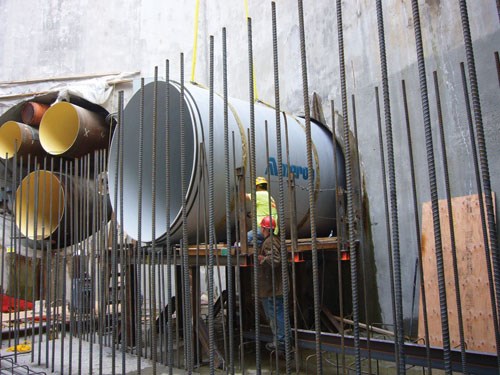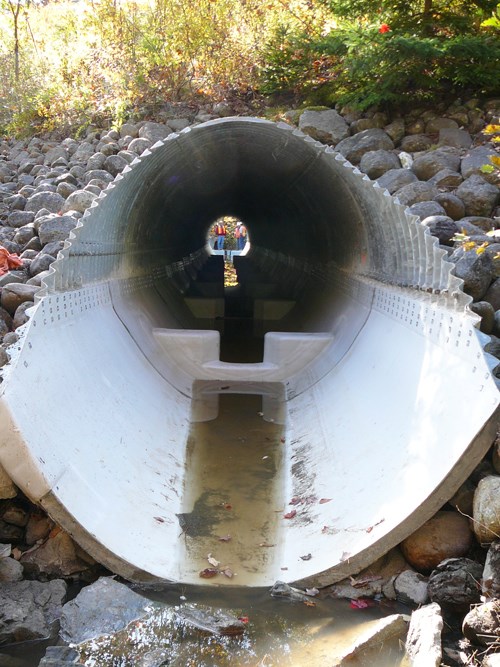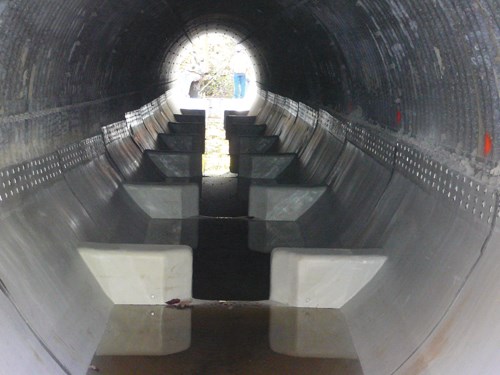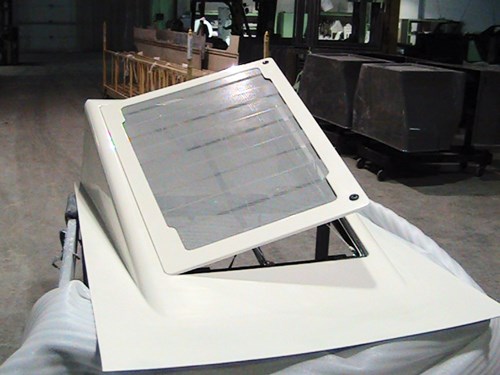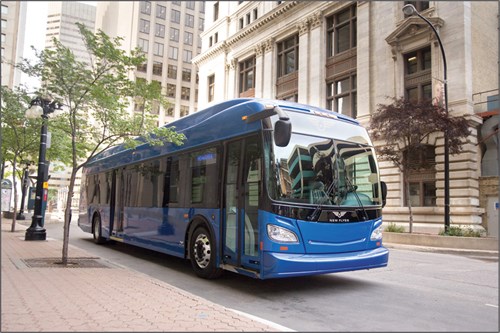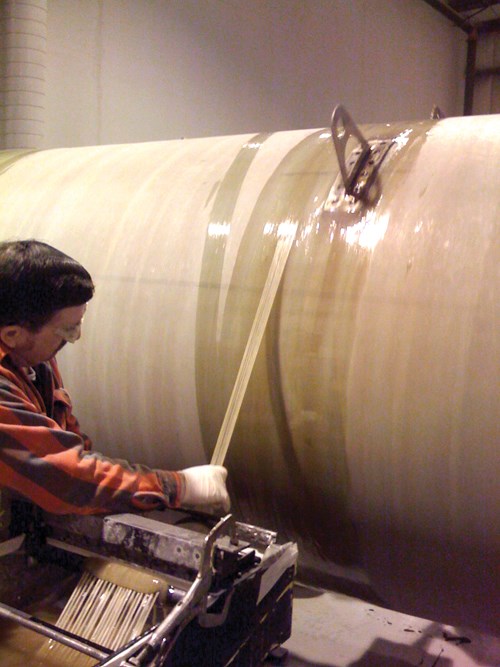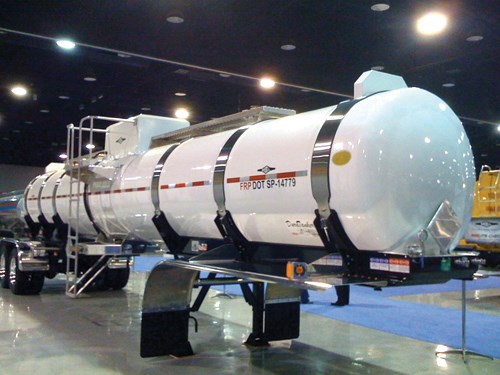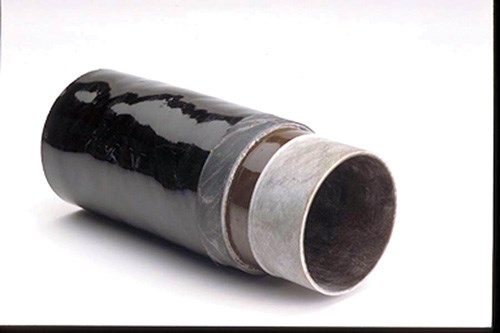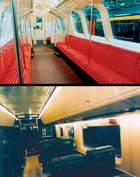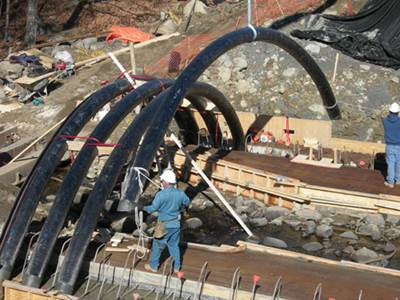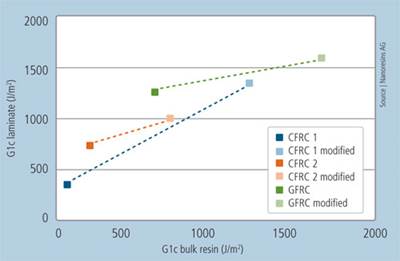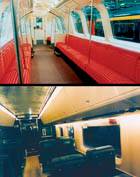Tough resins for aggressive environments
New thermoset systems drive composites deeper into markets where fire, corrosion, stress and fatigue are ever-present threats.
Fiber-reinforced thermoset resins have earned a place in the “industrial” applications sector, that catch-all descriptor that encompasses applications in which toughness and corrosion-, fire- and fatigue-resistance eclipse aesthetics.
Thom Johnson, corrosion industry manager, Ashland, LLC (Dublin, Ohio), believes fiber-reinforced thermoset composites are poised for substantial industrial growth in the next decade. “Composites are well known for their outstanding corrosion performance in the chemical industry,” he says. “Now, we are seeing rapid adoption of this material science in mineral processing, wastewater treatment, air-pollution control and numerous other aggressive corrosion environments,” says Johnson. “Not to mention the potential in infrastructure and engineered structures, such as bridges, columns and beams,” he adds. “As a percentage of the total, composites represent less than 5 percent of the bridge market, so there is a huge opportunity to expand in this arena.”
Expanding markets have prompted the development and use of a greater variety of “industrial-grade” resin formulations. Epoxy vinyl ester systems have long dominated the industrial composites scene, but the use of unsaturated polyesters and epoxies is growing, albeit at opposite ends of the cost spectrum.
Observers cite several reasons for the shifting emphases. “We continue to see a demand in industrial applications for resins that require enhanced physical properties — resins that are tougher, have higher heat resistance and higher corrosion resistance,” says John McAlvin, R&D manager at resin supplier AOC Resins (Collierville, Tenn.). And, according to Johnson, shifting conditions in materials pricing will play a big role. “With China and India gobbling up metals and metal alloys at an ever-increasing rate, metal prices are escalating rapidly,” he explains. “With the vigorous increase in metal prices, composites continue to become more and more attractive, not only from a performance standpoint but an economical one as well.”
As these factors converge, resin formulators are commercializing a host of newly designed thermoset resin systems that could drive potentially significant expanded use of fiber-reinforced plastic (FRP) in several segments, including some in which it currently has only a small foothold.
Bridges and beyond
After a period of stagnation, FRP composites are again gaining ground in bridge applications — spurred on by several successful research and development programs. The Bridge-in-a-Backpack concept developed by the University of Maine’s (UMaine) AEWC Advanced Structures and Composites Center (Orono, Maine) has been used, to date, to build five Maine bridges, exploiting AEWC’s hybrid composite/concrete arch concept (see “Bridge costs cut ...." under "Editor's Picks”). Several additional bridge projects are planned for this year. Hybrid Composite Beam (HC Beam) technology, developed by John Hillman and manufactured by Harbor Technologies (Brunswick, Maine), uses a similar composite/concrete combination to build highway bridges in Illinois and New Jersey, and it is currently in use by the Maine Department of Transportation (Maine DOT) for the Knickerbocker Bridge in Boothbay. In all, 64 HC Beams were constructed for the bridge. These are but two of a number of similar efforts to carve out an opportunity for composites in the general category of premanufactured stay-in-place (SIP) forms for concrete work now used in a variety of infrastructure and marine applications.
“Increased FRP use in the bridge market is spawning applications in other areas of infrastructure,” says Johnson. In Maine, for example, the DOT provided funding under the Composite Bridge Initiative to demonstrate the viability of composite liners for rehabilitation of steel culverts near Amherst, Maine, that were heavily degraded by rust, weakening the culvert invert (the elevation at the bottom of the inside of a culvert that aids proper drainage).
Replacement of degraded culverts disrupts vehicle traffic and can be expensive — up to 20 times the cost of rehabilitation, reports AEWC. Although reinforced-concrete invert liners are common, they can be labor intensive, requiring several thousand feet of rebar, extensive formwork and the use of heavy equipment. Further, they promise a service life of only 20 to 25 years.
In sharp contrast, Kenway Corp.’s (Augusta, Maine) hybrid composite culvert repair system reduces liner project duration by providing a mostly prefabricated solution that can be installed by hand. Further, the service life for its system, Kenway says, exceeds the 75 years once claimed by early proponents of reinforced concrete.
UMaine’s AEWC led the design, analysis and proof-of-concept testing while Kenway manufactured and installed the FRP panels. Cook Composites and Polymers (CCP Composites, Kansas City, Mo.) supplied trademarked Epovia RF1001L-00 — an unpromoted, bisphenol A-based vinyl ester resin designed for infusion of the glass-reinforced liner panels. The Epovia line of resins also is available worldwide through CCP’s sister company Cray Valley (Paris, France).
FRP panels were built, inspected and fully cured at Kenway’s factory. The Epovia resin’s low viscosity (100 cps) eases infusion of the large panels, which measure 10 ft/3m long by 8.6 ft/2.6m in diameter with a thickness of 0.28 inch/7 mm. The FRP panels were attached to the existing culvert in 2009 via powder-actuated fasteners that transfer the thrust load in the culvert from solid steel to the FRP liner. The space between the FRP panels and the existing culvert was filled with a Portland cement-based grout mix to stiffen the FRP. Custom-fabricated internal weirs and an integrated fish ladder were added to facilitate lake access for spawning fish.
A recent review of the Amherst repair demonstrated that the liner is performing well in the face of the extreme fluctuations in Maine’s weather conditions. Three additional composite culvert repair systems have been installed in Ebeemee and Indian Townships in central Maine. All three projects were competitively bid. In each case, the composite repair system came in as the low bid in competition against traditional repair methods that use concrete or shotcrete (concrete applied via a high-pressure hose). According to AEWC, applications for composite liners include water and sewer mains, erosion protection and bridge rehabilitation, including decks, beams and columns.
“A new segment is beginning to open up around premium structural performance without the need for premium corrosion performance,” explains Johnson. “The segment appears to be defined by good weatherability, but from a structural/mechanical standpoint rather than aesthetics,” he adds. “The need is for moderate corrosion-resistance, as compared to steel, concrete and wood, and reasonable fire resistance.”
Ashland’s answer is a new line of Derakane epoxy vinyl ester resins, the first of which is Derakane 610C-200. “Composite bridges were the initial target for this product line, but the target market has gone far beyond that now, including structural composite columns, beams and other premium infrastructure applications,” says Johnson.
“Most of the epoxy vinyl esters out today are engineered first and foremost for corrosion, and secondarily for structural or mechanical properties,” explains Johnson. “But when you’re building a bridge, a subway platform, a column or a beam, generally the most corrosive element the structure will be exposed to is salt spray or seawater,” he says. “The composite needs to weather well, but it doesn’t need to be resistant to strong acids or bases.”
Derakane 610C is designed to resist corrosion as well as or better than an isopolyester, yet deliver the structural performance of a vinyl ester, says Johnson. Infused parts made with the new Derakane resin have achieved Class II flame-spread results as measured by ASTM E-84 testing protocols.
Eurorail standards prompt changes
With the recent emphasis on light rail and high-speed rail, municipalities are extending their rail lines and building new stations and platforms, which creates many opportunities for FRP in not only traditional applications (third-rail covers, cable trays and seating) but also in railway station infrastructure.
“FRP has been used for some time in tactile flooring on platforms and third-rail covers,” explains Johnson. “Now it is showing up in rail platforms, both above and below ground, for flooring, as well as integrated structural solutions for whole platforms.”
New European Union standards for fire protection of railway equipment (EN TS 45545-2) are expected to be mandatory in 2011-2012. These standards are driving the move to eliminate halogens and carcinogenic, mutagenic or toxic-to-reproduction (CMR) substances in thermoset resin chemistries. The primary concern is the toxicity of smoke in enclosed spaces, such as mass transit railcars, ships and buses. “Current efforts target additives, such as phosphorous-based compounds and intumescent resins, to displace reactive brominated systems,” says McAlvin, “but it’s tough to match both the performance and the cost of these systems.”
One of the most common halogen-free alternatives for thermoset resins is the addition of the mineral flame retardant alumina trihydrate (ATH). At high temperatures, ATH releases water molecules, which quench the surface of the surrounding materials and provide flame retardance and smoke suppression without emitting toxins. AOC offers its trademarked Firepel K320-A, which McAlvin says is cost-competitive with brominated systems yet offers slightly lower fire-retardant (FR) properties.
The relatively high loading of ATH required to impart adequate flame retardancy can have a negative impact on the physical properties of the finished product (see "Passenger safety" under “Editor's Picks”). According to research from Cray Valley/CCP, it will be difficult for most ATH-filled conventional unsaturated polyesters to meet Europe’s new flame-spread and heat-release standards unless the resin content is very low, creating high density and high viscosity.
One solution may be optimized ATH fillers, such as those available from Huber Engineered Materials (Atlanta, Ga.), which supplies a range of nonhalogen fire-retardant additives, including ATH, magnesium hydroxide (MDH), and molybdate complexes. The company’s MoldX optimized ATH products reportedly offer lower viscosity as compared to typical ATH products, allowing compounders to achieve higher loadings without sacrificing process viscosity in mass-transportation applications. MoldX A100, which has a fine particle size and unique particle distribution, is capable of loading levels from 250 phr to 400 phr, and is suitable for SMC, BMC, hand layup and pultrusion.
Another solution is a new generation of halogen-free and CMR-free unsaturated polyesters from Cray Valley called FireBlock, targeted specifically to mass-transportation applications. The FireBlock technology, which won the 2011 JEC Innovation Award for “Materials,” is charged without halogenous compounds and antimony trioxide. It uses intumescence to create a resin that is not only fire retardant, but also fire resistant — meaning the structural properties of the resin remain during a fire. Under thermal stress, the surface of the resin chars, forming a carbon layer that effectively shields the laminate from flame. The technology reportedly offers better fire resistance than steel at flame temperatures of 2000°C/3632°F.
FireBlock resins boast low density — approximately 1.39 kg/L compared to 1.6 kg/L for heavily filled unsaturated polyester resins — which makes them suitable for weight-sensitive applications, including parts for railcars and buses.
Carlson Engineered Composites Inc. (Winnipeg, Manitoba, Canada) is using FireBlock Norsodyne H 81269 TF for several parts on Winnepeg-based New Flyer’s Xcelsior intercity bus. In all, Carlson manufactures more than 50 interior and exterior FRP parts for the Xcelsior, and all of the interior components meet Docket-90-A fire safety standards recommended by the Federal Transit Admin., a branch of the U.S. Department of Transportation. Many states now require the passenger areas of mass-transit buses to meet Docket-90 standards.
“The Norsodyne resin offered improved fire retardancy and production efficiency compared to our previous FR resin,” says Rob Haller, Carlson’s engineering manager. “Although the cost per kilogram was higher for the Norsodyne resin, the increase was offset by the elimination of processes and materials required for filling with ATH because Norsodyne is prefilled,” he adds.
FireBlock resins also are available for pultrusion, and Carlson is testing Norsodyne I 81268F, a FireBlock resin formulated for resin transfer molding.
Bleach transport expands market for FRP
Premium corrosion applications, such as tanks, piping and ducts that contain highly corrosive liquids and gases continue to be a strong market for fiber-reinforced thermosets. Yet, according to Johnson, when other materials used in corrosive environments (steel, higher metal alloys and coated concrete structures) are considered, FRP has only a single-digit percentage share in this market. “It is really an embryonic market for composites, despite the fact that this proven technology has been in place for more than half a century,” he emphasizes. And it’s a big market. The World Corrosion Organization (New York City, N.Y.) estimates the worldwide direct cost of corrosion prevention, including repair and replacement, exceeds $1.8 trillion (€1.4 trillion) annually.
One area that holds great potential for expanded composites use is in the transport of bulk chemicals. Bulk chlorine, for example, has traditionally been shipped via rail, but shipping costs have been rising amid concerns about risks associated with moving such a dangerous chemical through major metropolitan areas. (Bulk chlorine is the feedstock used to make sodium hypochlorite — commonly known as bleach — which is used for wastewater treatment.)
One approach to eliminating the shipment of bulk chlorine is to haul high-concentration sodium hypochlorite (24 percent rather than the standard 12 to 14 percent) to regional distribution facilities where it can be cut based on customer specifications. Water treatment facilities typically use 12.5 percent sodium hypochlorite. As bleach producers move away from rail transport in favor of cargo tankers, new infrastructure will be necessary to support the additional volume.
Chris Kellogg, senior VP, national business development, Corrosion Companies Inc. (Washougal, Wash.), estimates that each railcar equates to between 12 and 20 cargo tanker loads. Such an increase in demand for cargo tankers could be a boon for Corrosion Companies and others that manufacture filament-wound FRP tankers because the latter have steadily replaced steel-lined tankers in recent years, due mostly to reduced weight and an attractive service life of 30-plus years.
“Currently, we’re conducting tests to determine what impact this higher-concentration bleach will have on the lifecycle of the composite barrier liner in our composite cargo tankers,” says Kellogg. “At 12.5 percent sodium hypochlorite, we typically see a five- to seven-year service life for corrosion liners. Although we’re targeting 10 years of service life.”
The company’s composite cargo tanker features a filament-wound glass-reinforced epoxy vinyl ester (Ashland’s Derakane Momentum 411-350) for its barrier layer, as well as a new patented corrosion-barrier monitoring system, which also employs Derakane 411. Based on bisphenol A epoxy resin, Derakane 411-350 resists a wide variety of acids, alkalis, bleaches and solvents.
According to Johnson, bisphenol A epoxy vinyl esters have become the industry standard in the corrosion-resistant resin market because they have only two ester groups per molecule. This enhances the resin’s chemical resistance because the larger the number of ester groups in a vinyl ester system, the greater the resin’s susceptibility to chemical attack.
It’s critical to protect the structural portion of the tank from corrosive chemicals that, if left unchecked, could cause catastrophic failure. Corrosion Companies has developed its trademarked DuraShield system, which enables users to electronically monitor the condition of the corrosion barrier in the tank’s liner, ensuring that it is intact and chemicals are not leaking through to the structural portions of the shell. The liner can be monitored either continuously or by way of spot checks. Prior to this, liner degradation could be measured only by a technician from inside the tanker, and such inspections were typically done only once per year.
The DuraShield system places a carbon veil in the Derakane vinyl ester resin in a layer behind the corrosion barrier. “Because carbon is conductive, we can hook it up to a conductivity system that measures whether or not moisture is present,” explains Kellogg.
In addition to new construction, the DuraShield barrier system can be added when tankers are relined or by using a Monitored Filament Insertion (MFI) technology developed by BRER Technical (Bellingham, Wash.). With MFI, extremely fine and inert metallic filaments are inserted (without predrilling) into fully cured laminate behind the barrier layer in critical areas — near a drain fitting or head or shell joint — to allow for spot verification of laminate conductivity and saturation.
Corrosion Companies partners with Beall Corp. (Portland, Ore.) to trailerize its cargo tankers, which are constructed with a balsa core and use fiber-reinforced Derakane 411 through to the exterior shell. Glass-reinforced Derakane 510N is used on the exterior for fire retardance. Other resins and combinations of liners are also used, depending on the chemicals that the tanks will haul.
“We chose Derakane 411 because of its tensile elongation properties,” says Kellogg. “The right material for a chemical cargo tanker needs to withstand corrosion, high pressures during off-load and dynamic loads during transport,” he adds. “We’ve had the best luck with an MEKP [methyl ethyl ketone peroxide] cure vs. a BPO [benzoyl peroxide] formulation. BPO provides a harder cure, which optimizes corrosion resistance but can result in a material that is too rigid and more likely to fracture under the dynamic loads of a cargo tanker. BPO cure is better suited for stationary tanks,” he explains.
In fact, long-term storage of sodium hypochlorite presents its own challenges, and a regional supply approach will likely require additional chemical storage tanks. Sodium hypochlorite is an oxidizing material that is stabilized by sodium hydroxide. This makes it very corrosive to conventional construction materials. Fiber-reinforced epoxy vinyl ester storage tanks reportedly offer 20 to 30 years of service life, compared to 7 to 11 years offered by linear high-density polyethylene and crosslinked polyethylene, reports Michael Stevens, a senior staff scientist at Ashland, and Paul Cohen, vice president at Diamond Fiberglass (Victoria, Texas). Stevens and Cohen conducted a series of tests to determine the resin system and corrosion-barrier construction that would provide the longest service life for sodium hypochlorite storage tanks.
The results showed that at ambient temperatures there was little difference between a brominated vinyl ester and a standard bisphenol A epoxy vinyl ester, while novolac epoxy vinyl ester showed some signs of resin attack. At 50°C/122°F, the brominated epoxy vinyl ester showed less resin attack than the standard bisphenol A epoxy vinyl ester. Tests also showed that high cobalt curing systems can cause faster resin attack (at elevated temperatures) and should not be used in the corrosion liner of sodium hypochlorite storage tanks.
Growth in FRP pipe
Thermosets also play a big role in FRP pipe, which offers longer life and less maintenance than conventional ductile iron or concrete pipe. Ameron (Houston, Texas) has produced fiber-reinforced thermoset pipe, mostly in epoxy and vinyl ester, since 1960. Today, the company offers a full line of FRP pipe products for industry, oil and gas, offshore, marine and fuel-handling applications.
The company’s trademarked Bondstrand CX is a one-piece, double-wall rigid FRP design for double-containment systems. “Secondary containment is an emerging market,” says Joie Folkers, VP, sales and marketing for Ameron’s Fiberglass Composite Pipe Group. “Currently, the biggest application for FRP coaxial pipe uses epoxy resins at gasoline stations. It’s ideal for pipe that handles hazardous materials, where leak detection is critical.”
The pipes and fittings are filament-wound or compression-molded glass-reinforced thermosetting resins — vinyl ester or epoxy, depending on the pipe diameter and pressure involved in the application. (Epoxy resins are typically used for pipes up to 40 inches/100 mm in diameter, limited by the necessity of a heat cure, and ambient-cure vinyl esters are used for larger sizes.) The double-wall construction provides sufficient impact resistance in corrosion- and abuse-prone applications for which single-wall FRP pipe is inadequate. A porous layer of inert granular material lies between the primary pipe and the secondary pipe, creating a small, liquid-filled interstitial space that offers rapid leak detection via the use of pressure sensors. Even a small leak will alter the pressure within the space, triggering a sensor-activated alarm. “The secondary pipe is wound directly on top of the porous layer,” explains Folkers. “With both pipe walls in one piece, they don’t move relative to each other.”
In large diameters, FRP pipes are proving to be stronger and lighter in weight than conventional metal options. In a novel approach, Ameron offers a large-diameter option with a vinyl ester liner and a reinforced polyester wall.
“It can be either a solid wall with glass-reinforced resin or a sand-core wall with resin and sand as a sandwich construction to give stiffness,” explains Folkers. “This design allows greater materials efficiency by placing the higher-performing vinyl ester on the wetted surface of the liner and then building up the pipe wall with the less-costly polyester.”
CIPP: eco-friendly resins
Fiber-reinforced polyester, vinyl ester and epoxy are all used in cured-in-place pipe (CIPP), which is commonly used to reline sewer pipes and other underground conduits, enabling rehabilitation of existing pipelines without resorting to expensive excavation and replacement. Uncured, glass-reinforced thermoset liners are pulled or pushed through the degraded pipe section, inflated, then cured. In most cases, cure is promoted by circulating hot water throughout the length of the installed tube. Recent innovations, however, use UV-curable resins. Installed pipe sleeves are inflated with air and then cured by passing a wheeled UV-light “train” through it.
“CIPP offers many benefits compared to traditional concrete,” says AOC’s McAlvin. “Among other things, it offers a 50-year life span and eliminates the need to disrupt traffic during installation.”
The push for sustainable composites seen in the automotive and architectural markets is making its way to industrial applications as well, according to McAlvin. For example, AOC has developed an array of sustainable products that are based on biologically renewable content or contain recycled content. “Stricter ecological regulations and initiatives, in addition to the effect of volatile crude oil and natural gas prices, have accelerated the move to a more sustainable chemistry,” explains McAlvin.
AOC has developed both green and styrene-free resins specifically designed for CIPP. EcoTek L704-FAHG-VT is a high-molecular-weight isophthalic/unsaturated polyester resin thinned with vinyl toluene. The resin is free of hazardous air pollutants (HAPs), and it contains 16 percent renewable bio-derived content and/or recycled content. AOC offers four other EcoTek grades for CIPP applications, which can be either polyester or vinyl ester, including a formula that is UV-curable, with ultralow-VOC content.
“Traditionally, all of the ingredients for unsaturated polyester resins have been solely produced from petrochemicals,” explains McAlvin. By deriving a portion of the EcoTek resin’s high-performance building block — propylene glycol — from renewable bio-driven resources, such as corn and soybeans, AOC has been able to maintain the same physical and processing properties achieved with conventional isophthalic-propylene glycol resins, reports McAlvin.
“The EcoTek resins are all thermoset resins that are designed to be drop-in replacements for traditional unsaturated polyesters and epoxy vinyl ester,” he adds. “Because the resins are the same, there is no requirement to reproduce the long-term corrosion and flexural creep testing found in many CIPP specifications,” he adds.
Styrene-free and ultralow-HAP resins, which are designed to copolymerize with alternate low-volatile monomers, are especially attractive to municipalities, which often specify that CIPP applications be styrene-free to reduce both odors and emissions. The resins are currently used in CIPP sewer reliners, but potable-water applications are under investigation. The EcoTek family also includes styrene-free laminating resins and fire-retardant renewable/recycled resins. (For more on green thermosets, see "Resin systems update," under “Editor's Picks.”)
Formulating for the future
Although there is great potential for composites under the industrial umbrella, much of that potential remains untapped. But as the foregoing evidence indicates, resin suppliers are discovering ways to tailor resins to the demands of particular uses. Equally important, those tailored resins are beginning to address customer concerns about HAPs, odor and service life to ensure that composites will receive an increasingly positive reception in demanding applications where fire, corrosion and other hazards shorten the life expectancy of legacy materials.
Related Content
Plant tour: Joby Aviation, Marina, Calif., U.S.
As the advanced air mobility market begins to take shape, market leader Joby Aviation works to industrialize composites manufacturing for its first-generation, composites-intensive, all-electric air taxi.
Read MorePEEK vs. PEKK vs. PAEK and continuous compression molding
Suppliers of thermoplastics and carbon fiber chime in regarding PEEK vs. PEKK, and now PAEK, as well as in-situ consolidation — the supply chain for thermoplastic tape composites continues to evolve.
Read MoreManufacturing the MFFD thermoplastic composite fuselage
Demonstrator’s upper, lower shells and assembly prove materials and new processes for lighter, cheaper and more sustainable high-rate future aircraft.
Read MoreTU Munich develops cuboidal conformable tanks using carbon fiber composites for increased hydrogen storage
Flat tank enabling standard platform for BEV and FCEV uses thermoplastic and thermoset composites, overwrapped skeleton design in pursuit of 25% more H2 storage.
Read MoreRead Next
Bridge cost cut with inflatable arches
Stay-in-place composite formwork shortens installation, doubles service life of concrete bridge structure.
Read MoreResin systems update: The greening of thermosets
Thermoset resin formulators seek environmental benefits as customers demand reduced cost and increased performance.
Read MorePassenger Safety: Flame, Smoke and Toxicity Control
Tried, true -- and some new -- FST-resistant products for manufacturers of composites in rail- and road-based people movers.
Read More

